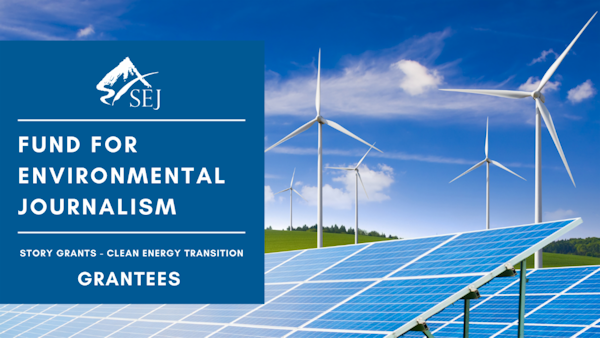 |
March 14, 2024 — The Society of Environmental Journalists' Fund for Environmental Journalism has awarded $47,605 for 11 projects selected through the 2023-24 round of competition for stories on the U.S. Clean Energy Transition.
Through these grants, SEJ will:
- Fund Journalists: 17 reporters, photographers, editors, designers and researchers will receive stipends or contracts.
- Increase Representation: 100% of the story projects focus on under-represented communities or share diverse perspectives on environmental issues.
- Support Local Stories: More than half of the projects will tell the story of a local community, ranging from the neighborhoods of Detroit to the Mojave Desert.
“Supporting these reporting projects with the generosity of our funders, we're not just subsidizing the work of journalists; we're investing in a future where underrepresented voices, from Detroit's underserved neighborhoods to Indigenous lands of the Columbia River Basin, can play their role in shaping the narrative of America’s clean energy transition," said SEJ Executive Director Aparna Mukherjee. “This is core to SEJ’s commitment to empowering the public and local communities with the information they need, a tenet for meaningful environmental progress and equity."
This independently juried competition is generously underwritten by Rewiring America and other foundation and individual donors to the Fund for Environmental Journalism, including donors to the "Lizzie" Fund for stories on environmental health, in memory of Elizabeth "Lizzie" Grossman.
The recipients of the Fund for Environmental Journalism 2024 Round are:
 |
Mario Ariza for "The Energy Divide: How a Red-Lined Electric Grid Hinders Minority Involvement in the U.S. Energy Transition"
The Black neighborhoods of Detroit get their power from an ancient and unreliable 4.8 KV electric system. It’s an old grid that can’t accommodate much in the way of solar panels, battery storage, electric vehicles, or heat-pumps without short circuiting. Despite investments to harden the city's grid and reduce blackouts, the local power utility, DTE, has no plans to replace a majority of the old lines, effectively shutting out many of the area's households from being able to participate in the green transition.
 |
Jake Bittle for "Is This Oil County Doing the Energy Transition Right — Or All Wrong?"
Kern County, the center of California’s century-old oil business, is betting on a carbon capture boom to help replace lost jobs and tax revenue. The county’s schools and labor unions are on board with the industry’s plan to convert old oil fields for carbon storage, but it’s unclear what the carbon capture business will look like or how much economic benefit it will provide. The debate over the industry’s novel transformation plan highlights how hard it is for oil-dependent counties like Kern to develop a green economy that stands independent of their biggest employers. Photo Credit: Jasmine Clarke
FEJ-funded project:
- "Inside a California Oil Town’s Divisive Plan To Survive the Energy Transition," Grist, May 15, 2024 (produced by Grist and copublished with High Country News). Also published on FastCompany.com.
 |
Isabella Breda for "The Columbia Basin and Its Coveted Minerals in the Clean Energy Transition"
A new mining rush has taken hold of the American West. The pressures are felt in the homelands of the Shoshone and Paiute people, near a proposed mine at Thacker Pass in Nevada, and in British Columbia on the Similkameen River, which sustains the waterways of the Confederated Tribes of the Colville Reservation, Similkameen People and hosts a mine at Copper Mountain. The Seattle Times’ Climate Lab, a recently launched community-funded reporting team, will embed with Indigenous communities whose traditional lands lie within the Columbia River Basin and explore what it would take to protect people, water and fish while pursuing a new clean global economy.
 |
Karina Brown (lead reporter), Nika Bartoo-Smith, Luna Reyna and Jarrette Werk for "Columbia River Treaty Tribes Revamp Green Energy"
In December, the Biden administration announced plans to fund work to replace the power generated by the four Lower Snake River dams. This will happen through green energy projects led by the four Lower Columbia River treaty tribes: Yakama Nation, Confederated Tribes of the Warm Springs, Confederated Tribes of the Umatilla Indian Reservation and the Nez Perce Tribe. The new agreement brought closer to reality the goal of environmental organizations everywhere: the breaching of the Lower Snake River dams. And it happened because of the political strategy and organizational capabilities of the tribes. Underscore News broke this story. Now, we’d like to trace what the agreement means – that tribes will lead the production of a massive amount of renewable energy in the Columbia River Basin.
 |
Victoria Estrada Vidal for "The Carbon Capture Rush in California’s Central Valley"
This project will take a deep look at carbon capture, a nascent industry playing a central role in California's goal of becoming carbon neutral by 2045. We'll explore the deployment of carbon capture in California's Central Valley and seek to answer these main questions: What are the potential consequences of implementing a technology that has not been proven safe in the long term yet? How will this industry impact the same communities that have suffered some of the worst effects of the carbon industry? What are more viable alternatives to carbon sequestration?
 |
Peter Fairley for "Tapping Off"
Dismantling natural gas grids can free up funds to accelerate electrification and head-off future energy injustice.
 |
Yessenia Funes for "Carbon Capture May Save the Planet. Louisiana's Historic Black Communities Will Pay the Price."
In the late 19th century, St. Rose, Louisiana, became a Freetown for formerly enslaved Black people. A century and a half later, their descendants continue to fight for liberation—this time, from polluters. In 2017, they defeated a planned expansion for an asphalt refinery. Now, they’re challenging a proposed $4 billion carbon capture plant billed as crucial to the clean energy transition. This 2,000 to 3,000-word story will explore the tensions between this Cancer Alley community and the Biden administration’s billions-dollar gamble on carbon capture and hydrogen.
FEJ-funded project:
- "What Happens When a So-Called Climate Solution Risks Your Community’s Safety?" Vox, August 9, 2024.
 |
Gloria Gonzalez for "Puerto Rico’s Challenging Clean Energy Transition"
There is arguably nowhere in the United States where the clean energy transition is more important than Puerto Rico, particularly due to a legacy of environmental racism going back decades that has left citizens in the primarily-Spanish speaking U.S. territory disproportionately impacted by water and air pollution. The archipelago is also incredibly vulnerable to extreme weather events such as 2017’s Hurricane Maria, which decimated the territory’s energy grid and contributed to the estimated 2,975 deaths caused by the storm. Puerto Rico has a target of getting 100% of its power from renewable energy by 2050 but is nowhere near achieving that goal. This reporting project will be an in-depth exploration of the challenges to Puerto Rico’s clean energy transition.
 |
Brooke Larsen for "Workers’ Rights in the Energy Transition"
For years, workers in wind and solar industries have experienced poor conditions, including low wages, long travel between worksites, unaffordable lodging, racism, sexual harassment and more. The combination of a growing labor-climate alliance and new federal investments in renewables from the Inflation Reduction Act may shift labor standards, though. This story will investigate labor conditions in the energy transition and see how Biden’s promise of good clean energy jobs is playing out on the ground.
 |
Joan Meiners for "Power Play: A Rural Community Fights Back Against Neighborhood Pollution From a New Gas-Fired Power Plant out in the Arizona Desert, Where Solar Would Thrive"
In the remote Mojave Desert one hundred miles south of Las Vegas, a community of seniors and farmers living quietly along the banks of the Colorado River are rising up to question Arizona’s commitment to clean energy. Photo Credit: Michael Rice
FEJ-funded project:
- "A Solar Ban, a Gas Power Plant and the Rural Retirees Firing Back at Dirty Energy," AZCentral | The Arizona Republic, April 7, 2024.
- "In Sunny Arizona, a Relocated Gas Plant Ignites Questions Over Who Profits and Who Pays," AZCentral | The Arizona Republic, June 28, 2024.
 |
Caitlin Myers for "The Rush for Critical Minerals Will Change Arkansas"
Southern Arkansas was blessed and cursed with abundant oil resources, and now, may contain one of the largest reserves of lithium in the world. It's also a region in steep economic decline, with a lack of economic transition deeply hurting the largely Black, rural communities around the Smackover Oil Formation. This story will follow the lithium boom in Arkansas and its effects on former oil communities facing new benefits and consequences from the clean energy supply chain.
FEJ-funded project:
- "Deja Vu Comes to Arkansas As Lithium Follows Oil," Grist, September 25, 2024. Also published on Energy News Network.
About the Fund for Environmental Journalism
SEJ's Fund for Environmental Journalism invests in public service reporting on environment and the journalists who produce it. FEJ grants support development and dissemination of significant coverage that otherwise could not be completed. Winning projects will be selected by an independent jury of journalists based on newsworthiness, topical relevance, publication plan, and track record of the applicant, among other factors.
Fund for Environmental Journalism story project grants from 2010-2024 have been funded by The Arthur Vining Davis Foundations, Bullitt Foundation, Burning River Foundation, Compton Foundation, Cornelius King Foundation, Cornell Douglas Foundation, Doris Duke Charitable Foundation, Energy Foundation, Environmental Defense Fund, Gordon and Betty Moore Foundation, Grantham Foundation for the Protection of the Environment, The Heinz Endowments, Hewlett Foundation, The Nature Conservancy, The Pew Charitable Trusts, The Religion & Environment Story Project, Rewiring America, Spring Point Partners, Walton Family Foundation, The Wilderness Society, Wyss Foundation, and individual members and friends of the Society of Environmental Journalists.
Grantees retain full editorial control of FEJ-funded coverage. Donors have no right of review and no influence on story plans made possible in part by their contributions. Binding agreements between donors and the Society of Environmental Journalists and between SEJ and grantees of its Fund for Environmental Journalism reinforce this policy of editorial independence.
Your gift makes a difference! Please support new projects by making a donation today.












 Advertisement
Advertisement 



